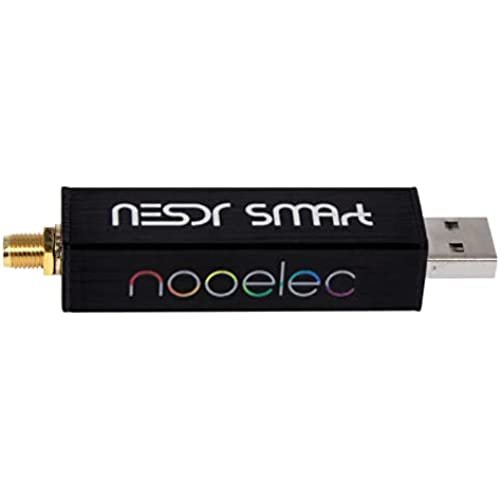
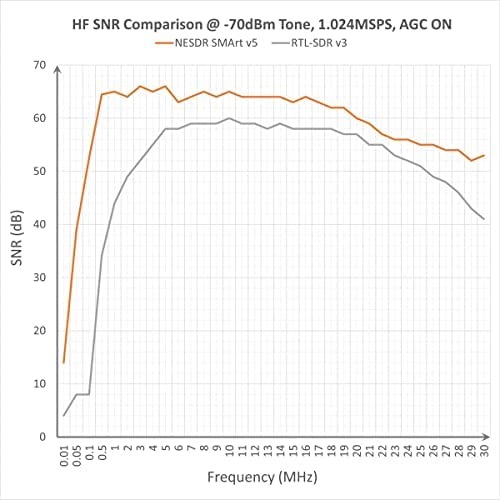
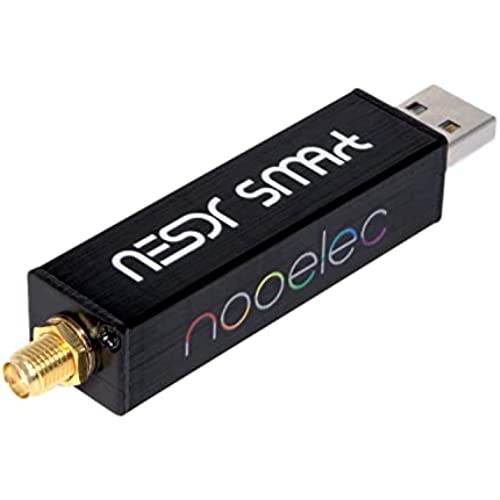
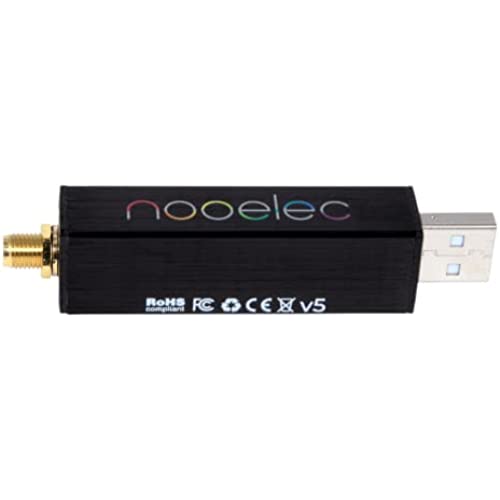
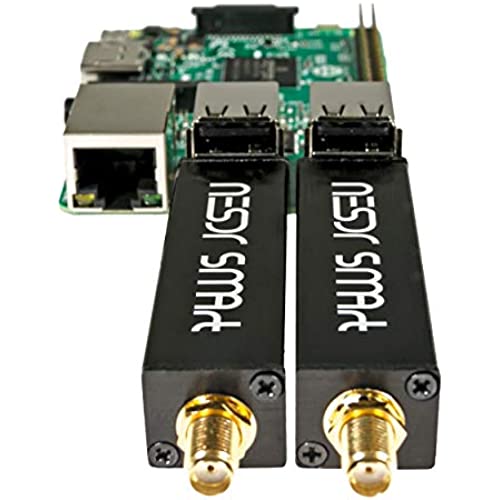
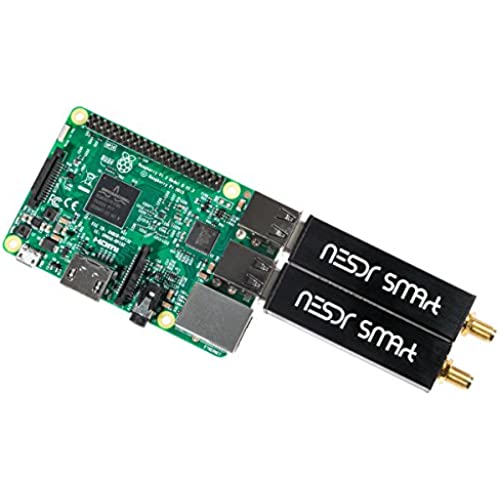






Nooelec RTL-SDR v5 SDR - NESDR Smart HF/VHF/UHF (100kHz-1.75GHz) Software Defined Radio. Premium RTLSDR w/ 0.5PPM TCXO, SMA Input & Aluminum Enclosure. RTL2832U & R820T2 (R860)-Based Radio
-

Bob Arizona
> 24 hourFirst off I have been a ham radio operator since the 80s and hold an extra class (top) rating. I was looking for a very portable scanner that I could take along on my travels to listen to airline frequencies (also a private pilot) that wouldnt take up a lot of space in my full under seat bag nor look suspicious while in the airport, as a standard scanner might. The good news is that it does work, the bad news is that there are some limitations. The idea of slapping a small antenna on it and plugging into a cell phone or tablet with an OTG adapter is not feasible. The main issue is that the SDR radio draws more power than the OTG via the usb port can deliver. Solution, purchase a powered USB cable. This allows you to plug one end into a charging battery, which I always travel with, which powers the radio and doesnt drain the phone or tablet. https://www.amazon.com/Degree-Angled-Female-Enhancer-Adapter/dp/B071X8BCFH/ref=sr_1_3?keywords=powered+usb+cable+otg&qid=1552141974&s=gateway&sr=8-3 Then you will need an extension USB cable to the phone or tablet so you can place the unit in suitable position, and any adapters to your particular phone, USB to C, etc. Easily done and not expensive. Then there is the antenna! The beauty of this Radio is that it is extremely wide band covering below commercial FM to 1.700 Ghz or more. This covers most of the commercial bands including Aircraft, first respondeners, most walkie talkie and even cell phones. Note that many systems on those bands are encrypted and not easily monitored. The beautiful thing about this SDR radio is the spectrum display, or waterfall which will show you a chunk of the band and all the active frequencies. You are able to simply slide your virtual vernier to a hot spot and monitor the frequency. In addition there is a running visual display of all the activity on that part of the spectrum so you can see frequencies with intermittent activity. You also can easily select all the common radio modulation schemes, like AM, FM, FM narrow, amateur radio SSB USB, LSB and CW, etc. Of course, you will need an antenna and unfortunately antennas are tuned to the frequencies you want to listen to. Very critical if you are transmitting, less so for receiving. For example, international ham radio frequencies have a wave length of around 65 feet (20 meters) the length of a full wave antenna. 1/4 wave antennas also work at approximately 16 feet. Not practical to carry around plus you will need an additional adapter (Ham it up) to receive the lower frequencies. On the other hand a 1700 MX signal close to the top end of LTE cellphone data as a full wave length of 6. For receiving a wide band scanner antenna is probably your best bet like: https://www.amazon.com/AEcreative-Wide-Band-Scanner-BCD396XT-BCD436HP/dp/B07HWLSNQP/ref=sr_1_8?crid=3RCJLW4EP4MW&keywords=wideband+scanner+antenna&qid=1552143429&s=electronics&sprefix=wide-band+scanner+antenna+%2Celectronics%2C205&sr=1-8 When looking for an antenna you will need an SMA female connector. Lastly, you will need software for your phone, tablet or computer. Some of it is open source and free (donation) and others have a demo version and a small fee ($5-10) for the Android / IOS versions. Try before you buy! All in all a great product with serious applications.
-

Sam The Sham
> 24 hourOther than the getting the appropriate drivers installed (hard as Chinese math), its a very good product. The driver problem was my failure to read instructions properly on NooELCs web site. My bad. The stick works very well. Sensitivity level is outstanding and doesnt drift. I have always had great success with NooElec products and HIGHLY recommend the company and this Premium RTL-SDR stick to you.
-

Joe
> 24 hourI thought this would be my entrance into the world of SDR, but it overheated easily. It would be operational for about 10 minutes or less before overheating and refusing to work. I was using Ubuntu and a Chromebook. My second occasion working with it, it just went kaput. I dreamed of setting it up in a cloth ice pack to reduce the heat, but alas, it never worked again on the Chromebook! So, I tried installing a different driver and attempted a Windows-based SDR platform on my desktop unit and... nothing. Its a paperweight now.
-

Don
> 24 hourI am using the NESDR as a panadapter with my ham Yaesu FT450D transceiver. I installed a first IF buffer board and rear panel connector on the FT450D. When connected to this dongle, using HDSDR software, this allows the HDSDR software to display a wideband view around the tuned frequency on the transceiver. The device works very well for the purpose. The TXCO temperature compensated oscillator really improves the frequency stability over a cheaper bare-bones device. This insures the frequency displayed on the transceiver and the panadapter agree. The problem with this model is that the four USB contacts within the metal USB connector shell are set too far back from the tip of the connector. The mating socket makes insufficient contact for a reliable connection. The slightest movement of the dongle or extension cable will disconnect the device from the computer. Contact is very intermittent. This problem was on any USB socket or extension cable. Other users have reported the same issue. I contacted Nooelec. While they were somewhat helpful, they seemed unaware of the issue. I finally resolved the problem on my own by filing a few millimeters off of the end of the USB connector with a flat file. This allows the connector on the dongle to insert farther into the socket making reliable connection. No more disconnects.
-

WhatsTheHurry?
> 24 hourI have both the NESDR Smart v4 and the NESDR Smartee v2 (the same but with bias tee built-in) and they both offer equal performance that is notably better than generic RTL SDR dongles from China. The 0.5 PPM accuracy of the temperature-compensated crystal oscillator (TCXO) is great (meaning that it tunes the exact actual frequency you select digitally and stays there) plus the noise level is 2-3dB lower than no-name products. Just as important, the number and strength of interfering signals in the form of images, spurs, and birdies across the bands is substantially lower in these Nooelec products. Well worth the extra few dollars.
-

Sigma
> 24 hourIts very fun to scan through all the frequencies to see whats out there. Its a very good entry point into the world of SDRs! The only negative I see is that the dongle seems to get very warm after about 20 minutes of use, but doesnt seem to actually overheat or get much warmer once its up to temperature. This may be by design, but I wouldnt leave it plugged in overnight or anything.
-

MW
> 24 hourReally great SDR for the price. If youre familiar with this type of SDR, youll know its pretty much an accident that these things work perfectly for this application. I really like NooElecs enclosure. Its very sturdy and holds up great. The chip quality is fantastic as well, and I have not had any frequency drift or tuning issues. One really important tip that I highly recommend: Keep it cool. It runs pretty hot. Not hot enough to really decrease its lifespan, but I measured it at around 110 degrees F when set at maximum gain. This temperature increase does add a lot of noise, so if you can keep it cool, you can save yourself a lot of trouble trying to find weaker signals. If you dont need it to be portable, say youre using it with a desktop, find something metal and use some CPU thermal compound to stick it to it. It does the job perfectly, and the temps lowered to around 90 degrees at peak. I stuck it to the steel case of a battery backup I have my computer hooked up to. I just put a drop of thermal compound between the enclosure and the metal of the battery backups case. Then I taped it on with some strong masking tape so it wouldnt come off. Works like a charm.
-

Ezra
> 24 hourI had the standard RTL-SDR.com dongle and it would freeze, get very hot and frequency drift a lot. After a few hours of operation it was unusable. I replaced it with the Nooelec NESDR Smart v4 SDR and Im happy as a clam. Works great, doesnt lock up, doesnt drift and everything works great now. Im very happy with it. I use CubicSDR as the software and its a great combination. I use it for tracking wildlife with radio collars.
-

TomcatEvE
> 24 hourIts all about the antenna. Unit performs fantastic.
-

Dave Riley
> 24 hourAdd said 100 khz - 1.7ghz Now i need a Hack 1 to make this unit receive where i am interested, LF MF HF Was not presented in truth SAD Otherwise works well...
